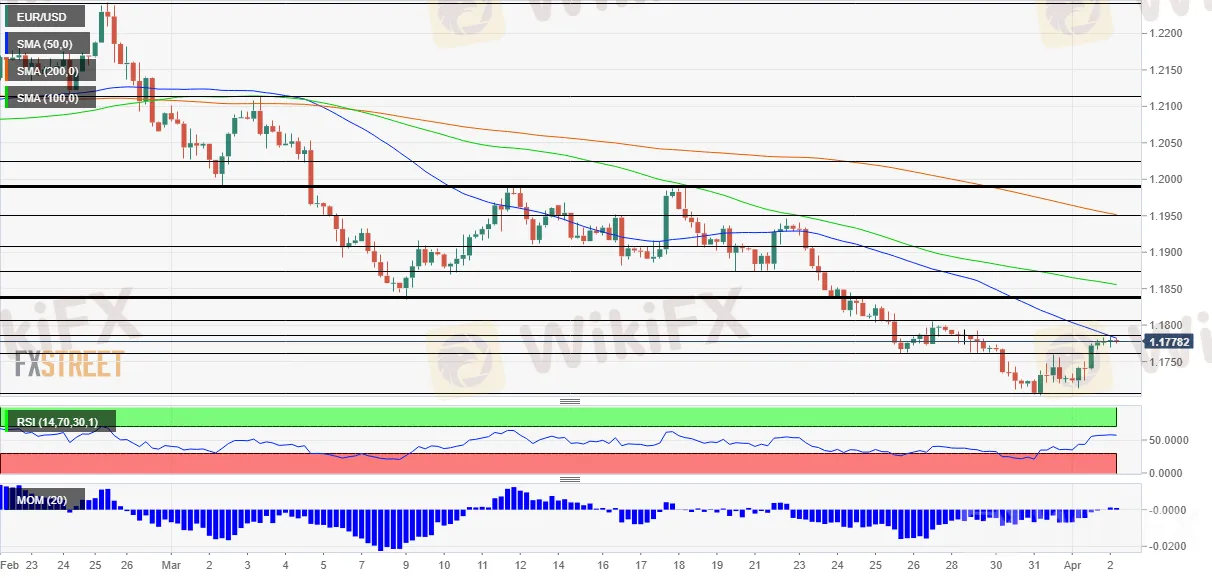简体中文
繁體中文
English
Pусский
日本語
ภาษาไทย
Tiếng Việt
Bahasa Indonesia
Español
हिन्दी
Filippiiniläinen
Français
Deutsch
Português
Türkçe
한국어
العربية
EUR/USD Forecast: End of the correction? Strong Nonfarm Payrolls may trigger a massive sell-off
Abstract:EUR/USD Forecast: End of the correction? Strong Nonfarm Payrolls may trigger a massive sell-off

EUR/USD has been able to recover amid a cheerful start to the second quarter.
Robust US jobs figures and low liquidity may send the dollar sharply higher.
Europe's virus issues heavily weigh on the common currency.
Friday's four-hour chart is showing bears remain in the lead.
Nonfarm Payrolls report are pointing to a positive outcome, and that may boost the dollar.
The ISM Manufacturing Purchasing Managers' Index shot up to 64.7 – the highest since 1983 and a sign of robust activity in America's industrial sector. This forward-looking survey included a leap in the employment component. The mix of optimism around vaccines, reopening in several states, and stimulus checks have all contributed to hiring. The question is how much. Some analysts foresee a leap of over one million jobs, but that could be over the top.
These all-important labor market statistics are published on Good Friday, a holiday in many parts of the world. Trading volume is limited and the lack of liquidity could result in significant moves.
US Nonfarm Payrolls March Preview: Optimism and evidence this time?
Nonfarm Payrolls Preview: Five reasons why hiring is set to skyrocket, dollar may follow
Leading toward this all-important release, the dollar has been on the defensive despite apparent economic strength in the US. Treasury yields remain in the driver's seat and they dropped after President Joe Biden presented his massive $2.25 trillion infrastructure spending plan. Why?
First, funding for this expenditure is set to come from tax hikes, therefore lessening the need for more debt issuance. With fewer bonds circulating, they are worth more – and the result is lower yields and therefore a weaker dollar. Secondly, Republicans are opposed to the scheme and Congress may substantially modify Biden's plan.
That dynamic may change if prospects of robust recovery raise inflation expectations and force the Federal Reserve to act sooner than later, and contrary to its current pledge. The next adjustment in markets depends on the NFP.
Moreover, if there is one currency the dollar has more to run against, it is the euro. Good Friday is a somber event in most of the old continent, which is under various forms of lockdowns. COVID-19 is raging in Europe and while vaccinations have picked up, they have reached roughly 12% of the population, in comparison to around 30% in the US and nearly half of Britain's citizens.
And if the Fed may raise rates in America due to higher inflation, the European Central Bank is far away from such a move. The Core Consumer Price Index disappointed with 0.9% annual in March, lower than expected and reflecting weakness.
All in all, the tables remain tilted in favor of the dollar and against the euro.
EUR/USD Technical Analysis

Euro/dollar has been able to reach levels last seen on Monday, but it remains on a downtrend as the four-hour chart clearly shows. Momentum and the Relative Strength Index are balanced while EUR/USD remains capped by the 50, 100 and 200 Simple Moving Averages. Overall, bears are in the lead.
Support is at the daily low of 1.1770, followed by 1.1760 and the psychologically significant 1.17. Further down, 1.1630 is the downside target.
Some resistance awaits at the daily high of 1.1785, followed by 1.1805, 1.1835 and 1.1875.
----------------
WikiFX, the world's No.1 broker inquiry platform!
Use WikiFX to get free trading strategies, scam alerts, and experts experience!
Android : cutt.ly/Bkn0jKJ
iOS : cutt.ly/ekn0yOC

Disclaimer:
The views in this article only represent the author's personal views, and do not constitute investment advice on this platform. This platform does not guarantee the accuracy, completeness and timeliness of the information in the article, and will not be liable for any loss caused by the use of or reliance on the information in the article.
Read more

KVB Market Analysis | 23 August: JPY Gains Ground Against USD as BoJ Signals Possible Rate Hike
JPY strengthened against the USD, pushing USD/JPY near 145.00, driven by strong inflation data and BoJ rate hike expectations. Japan's strong Q2 GDP growth added support. However, USD gains may be limited by expectations of a Fed rate cut in September.

KVB Market Analysis | 22 August: Gold Stays Strong Above $2,500 as Fed Rate Cut Hints Loom
Gold prices remain above $2,500, near record highs, as investors await the Federal Open Market Committee minutes for confirmation of a potential Fed rate cut in September. The Fed's dovish shift, prioritizing employment over inflation, has weakened the US Dollar, boosting gold. A recent revision showing the US created 818,000 fewer jobs than initially reported also strengthens the case for a rate cut.

KVB Market Analysis | 21 August: USD/JPY Stalls Near 145.50 Amid Diverging Economic Indicators
USD/JPY holds near 145.50, recovering from 144.95 lows. The Yen strengthens on strong GDP, boosting rate hike expectations for the Bank of Japan. However, gains may be limited by potential US Fed rate cuts in September.

KVB Market Analysis | 20 August: Gold Prices Remain Near Record High Amid US Rate Cut Expectations
Gold prices remain near record highs, driven by expectations of a US interest rate cut and a weakening US Dollar. Investors are focusing on the upcoming Jackson Hole Symposium, where Fed Chair Jerome Powell's speech will be closely watched for clues on the Fed's stance. Additionally, the release of US manufacturing data (PMIs) is expected to influence gold's direction.
WikiFX Broker
Latest News
Will Gold Prices Continue to Rise Due to Trump’s Tariffs?
Miami Firm Owner Pleads Guilty to $6M Ponzi Scheme Fraud
NBI Cebu Arrests Forex Trader for Illegal Investment Solicitation
PU Prime's "Feather Your Trades" Contest! Begin
eToro Files for IPO with $5 Billion Valuation on NASDAQ
Is FizmoFX a Scam? Fraud and Account Suspension of Traders
ALERT! Warning against Livaxxen
BOJ to Announce Policy Decision This Week, Market Bets on a Rate Hike
Crypto.com’s Dual Front Battle: European Progress and U.S. Regulation
SEC Charges Nova Labs for Crypto Fraud and Violations
Currency Calculator






